-
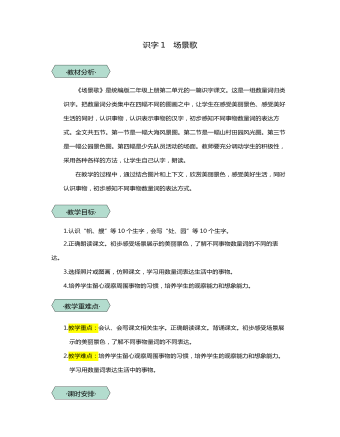
统编版二年级语文上识字1场景歌教学设计教案
《场景歌》是统编版二年级上册第二单元的一篇识字课文。这是一组数量词归类识字。把数量词分类集中在四幅不同的图画之中,让学生在感受美丽景色、感受美好生活的同时,认识事物,认识表示事物的汉字,初步感知不同事物数量词的表达方式。全文共五节。第一节是一幅大海风景图。第二节是一幅山村田园风光图。第三节是一幅公园景色图。第四幅是少先队员活动的场面。教师要充分调动学生的积极性,采用各种各样的方法,让学生自己认字,朗读。在教学的过程中,通过结合图片和上下文,欣赏美丽景色,感受美好生活,同时认识事物,初步感知不同事物数量词的表达方式。 1.认识“帆、艘”等10个生字,会写“处、园”等10个生字。2.正确朗读课文。初步感受场景展示的美丽景色,了解不同事物数量词的不同的表达。3.选择照片或图画,仿照课文,学习用数量词表达生活中的事物。4.培养学生留心观察周围事物的习惯,培养学生的观察能力和想象能力。 1.教学重点:会认、会写课文相关生字。正确朗读课文。背诵课文。初步感受场景展示的美丽景色,了解不同事物量词的不同表达。2.教学难点:培养学生留心观察周围事物的习惯,培养学生的观察能力和想象能力。学习用数量词表达生活中的事物。 2课时
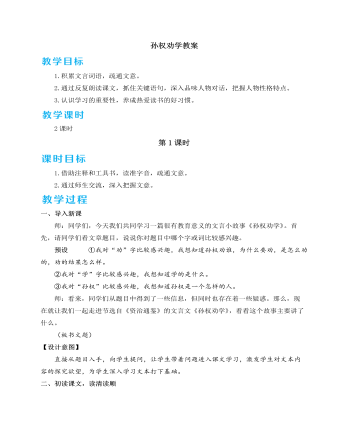
人教部编版七年级下册孙权劝学教案
(所有扮演吕蒙的学生举手,老师任选学生回答问题)预设 ①多读书能拓宽视野,丰富知识。②自己先天基础差,能力不足,就要靠后天的努力学习来争取进步。③用心听取别人的建议,并努力去做到最好。师小结:感谢三位接受我的采访!吕蒙先生的话让老师想起了冰心的名言:读书好,好读书,读好书。同学们,让我们与书籍同行,打好人生的基础;让我们以博览为志,拓宽视野。“腹有诗书气自华。” “问渠那得清如许?为有源头活水来。”愿同学们在知识的海洋里乘风破浪,扬帆远航!【设计意图】本环节采用记者采访的活动形式,由课内延伸至课外,最大限度地激发学生学习的兴趣。学生在活动中,不仅可以探究文章主题,更能切身体会到学习的重要性。四、布置作业1.课后自己整理、积累相关的文学常识和文言词语。2.比较阅读。通过比较《孙权劝学》和《伤仲永》,深化对课文内容的理解。
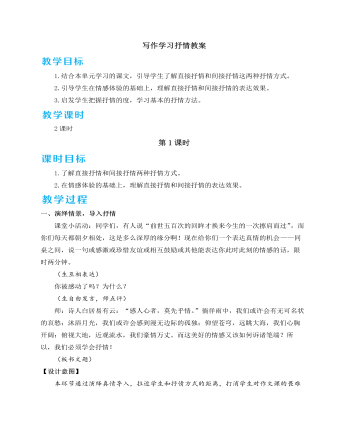
人教部编版七年级下册写作学习抒情教案
我们在湖边走着,在不高的山上走着。四周的风物秀隽异常。满盈盈的湖水一直溢拍到脚边,却又温柔地退回去了,像慈母抚拍着将睡未睡的婴儿似的,它轻轻地抚拍着石岸。水里的碎瓷片清晰可见。小小的鱼儿,还有顽健的小虾儿,都在眼前游来蹦去。登上了山巅,可望见更远的太湖。——郑振铎《石湖》(生根据师展示的原文,参考、揣摩名家笔下抒情方式的运用,体会抒情描写中以情动人的魅力)2.写一段话,抒发某种情感,如幸福、喜悦、痛苦、忧伤、渴望等。200字左右。提示:(1)可以描写场面、事物,也可以叙述故事;(2)情感的抒发要有内容,有凭借;(3)根据内容特点和表达需要,选择合适的抒情方式。(生自由习作后,小组内互评、修改)师小结:情贵在真,要注意抒发自己的真情实感。朱光潜曾说过:“作者自己如果没有感动,就绝对不能使读者感动。”在写作中,情感的抒发要自然,要水到渠成。
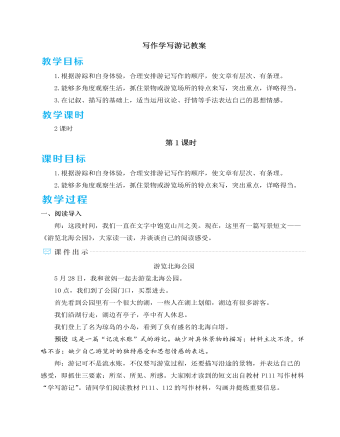
人教部编版语文八年级下册写作学写游记教案
4.组织材料师:一篇游记作品,既要有“灵魂”“血肉”,还得有“筋骨”——材料安排。请大家运用我们上节课学习的方法来组织材料。方法:(1)按照自己的游踪或独特体验,安排写作顺序。(2)能突出参观场所特征的要详写,其余的略写或不写。(3)丰富文章内容:适当加入叙事,引入一些典故、传说、史料、评价或诗文名句。示例:(1)写作顺序:以作者的参观路线为线索。(2)详略安排:详写鲁迅先生北京故居的工作室兼卧室,以突出鲁迅简朴、惜时的品质和忘我工作的精神品质;详写陈列大厅是为了赞扬先生的民族精神。其余的略写。(3)引入内容:引用古诗句“望崦嵫而勿迫,恐鹈之先鸣”,表现先生惜时的品质。(生交流,师点评)预设 (1)写作顺序:一楼的青铜器—二楼的陶器—三楼的古代画作。
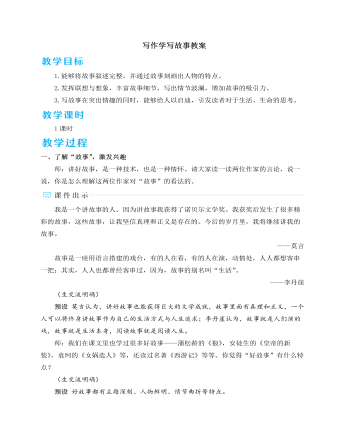
人教部编版语文八年级下册写作学写故事教案
师小结:《投诉母亲》中,“我”想让母亲辞职享清福,尽人子之孝心。没料到通往目标的路上障碍重重,解决一个障碍,又有一个新的障碍横在眼前,就这样一个个障碍将故事的矛盾冲突推向高潮。从让母亲辞职到放弃计划,顺从母亲,让故事有了戏剧性的收尾。这是运用了巧设障碍法让情节跌宕起伏。《错误的手套》中,母亲说“给孩子买副手套”,本意是让父亲给小外孙买手套,父亲却给女儿买了副手套,作者巧用语言的模糊性,使故事一波三折、情真意切。这是运用了巧设误会法让情节跌宕起伏。技法3:用巧设障碍法、巧设误会法写“情节曲折的故事”。4.归纳整合,明确技法师:共赏“好故事”,我们发现了三个技法。技法1:用“以小见大”的手法写“主题深刻的故事”。技法2:用对比手法写“人物鲜明的故事”。(1)通过人物在不同情境中的对比来突出人物性格特点。(2)通过人物之间的差异对比来突出人物特征。技法3:用巧设障碍法、巧设误会法写“情节曲折的故事”。
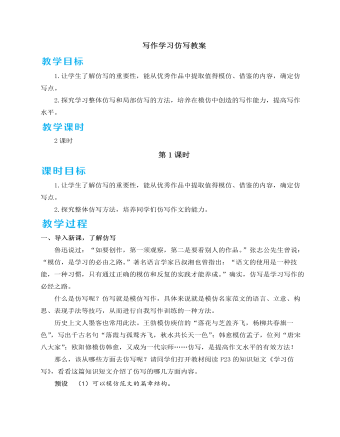
人教部编版语文八年级下册写作学习仿写教案
3.教师小结(1)仿写点分析。要认真分析、研究片段中的精彩之处,力求准确把握仿文的“外形”和“神韵”。 (2)仿写内容选择。选择自己熟悉的、有情感体验的内容,切不可为了“仿”而机械模仿甚至抄袭。(3)变通与创新。 分析名家名作的语言特点、写法规律,以“仿写”为阶梯、桥梁,达到写作的新高度、新领域。【设计意图】学生在阅读教学和句式仿写训练中对修辞手法、描写手法和表达方式等知识接触较多,如《社戏》教学中对心理描写手法的分析,《安塞腰鼓》课后布置的修辞手法的仿写训练,学生对此已有亲和感。本环节的主要目的在于让学生在实践中对仿写点的分析、仿写内容的选择、仿写的变通与创新产生切身的体悟。三、总结存储1.课堂小结学会根据需要恰当选择具体的、合理的仿写点,达到以“他山之石”来“攻玉”,“假名家之手”写“我心”的目的,是仿写的真正要义。2.实践演练完成课本P24“写作实践”第三题。
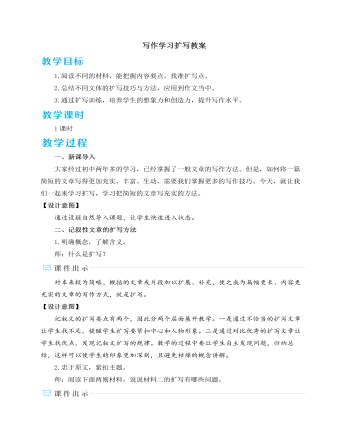
人教部编版语文九年级下册写作学习扩写教案
这一特点还着重体现在动词的应用上面,“鸟宿池边树,僧敲月下门”中的“敲”,就比“推”更能体现诗中以动衬静的特点。在字词上不断推敲,就能体会到诗歌语言高度凝练的特点。再说,古人创作古诗词,并不是写出来的,而是吟咏出来的,他们十分注重音韵在表情达意方面的作用。李清照的《声声慢》便是一个极好的例子,开头“寻寻觅觅,冷冷清清,凄凄惨惨戚戚”十四个叠字,读起来抑扬顿挫,缠绵哀婉,将李清照情绪上的失落、低沉,甚至哽咽展现得淋漓尽致。正因为诗歌的这三个鲜明特点,使得诗歌与别的文体区分开来,具有鲜明的个性。师点评:对于诗歌的扩写,要通过多种方式展现诗歌的主要特点。对诗歌的扩写练习,要求从诗歌意象、语言和节奏韵律三方面展开。首先,这篇习作从三个不同时代的诗歌总结出相同的规律——利用意象表达情感。其次,将古诗词与现代诗进行对比,展现了第二个特点。最后,以《声声慢》为例,详细分析了第三个特点。在紧密围绕诗歌特点的基础上,通过多种方法呈现了对诗歌的认识。

部编人教版四年级下册《 短诗三首》教案
一、导入课题,释义诗题1.【出示课件2】《纸船》——寄母亲我从不肯妄弃了一张纸,总是留着——留着,叠成一只一只很小的船儿,从舟上抛下在海里。有的被天风吹卷到舟中的窗里,有的被海浪打湿,沾在船头上。我仍是不灰心的每天的叠着,总希望有一只能流到我要它到的地方去。母亲,倘若你梦中看见一只很小的白船儿,不要惊讶它无端入梦。这是你至爱的女儿含着泪叠的,万水千山求它载着她的爱和悲哀归去。这是冰心先生的一首小诗。让我们一起朗读欣赏。诗歌,让我们用美丽的眼睛看世界。今天就让我们来学习冰心先生的三首短诗。
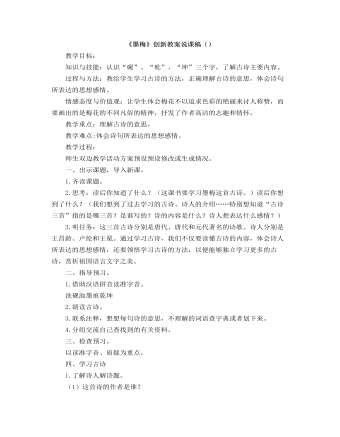
部编人教版四年级下册《古诗词三首》创新教案
二、指导预习。 1.借助汉语拼音读准字音。洗砚池墨痕乾坤2.朗读古诗。3.联系注释,想想每句诗的意思,不理解的词语查字典或者划下来。4.分组交流自己查找到的有关资料。三、检查预习。以读准字音、质疑为重点。四、学习古诗1.了解诗人解诗题。(1)这首诗的作者是谁?(2)《墨梅》作者:元代著名画家王冕。王冕(公元1287——1359)我国元代著名画家。字元章,号煮石山农,诸暨人(今浙江绍兴)。(3)这首诗的题目是什么?(墨梅。这是一首题画诗。墨梅,顾名思义,即为用水墨画的梅花。)(4)从题目上,你知道了什么?还想知道什么?(知道了这首诗写的是水墨画的梅花。想知道这幅梅花图是谁画的?墨梅有什么特点?诗人为什么要写《墨梅》这首诗?要表达自己什么样的感情?)
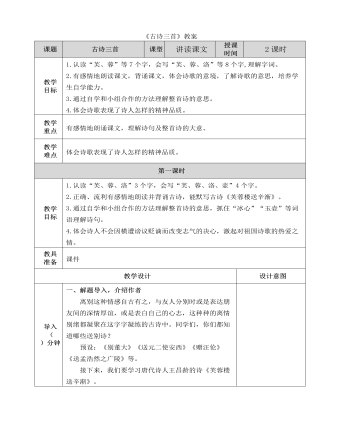
部编人教版四年级下册《古诗词三首》教案
四、品读诗文,赏析感悟1.品读前两句诗(1)请大家默读前两句,看看都写到了哪几种景物?(雨:什么时候下起了什么样的雨?江:江面上是一番怎样的景象?山:在作者眼里楚山什么样?诗中还暗含着两个人物)【课件出示9】(2)“连”“入”两个动词写“寒雨”表现一种怎样的气氛?(“连”“入”两个动词写“寒雨”的绵绵不断和无声无息,渲染出离别时的暗淡气氛。)“楚山孤”表达作者怎样的情感?(表达诗人离开朋友时的强烈的凄冷孤寂感。)【课件出示10】(板书:凄冷、孤寂感)(3)前两句有一对表示时间的词语:“夜和平明”,王昌龄一共写了两首,这首是天亮时在芙蓉楼送别辛渐时所作,另外一首描绘的是前一天夜里两人在芙蓉楼里饮酒话别时的情景。【课件出示11】(出示第一首诗)师:窗外秋雨绵绵,芙蓉楼内二人相对而坐,饮酒道别,这此情此景,给你一种什么感觉?(凄凉,忧愁)。这种情感凝聚在诗中的哪个字中?(孤)带着这种感觉,再读前两句。师:王昌龄才华横溢,官至县蔚,后来因事被贬谪岭南,在北返长安时在江宁县任职,在江宁数年,又遭人诋毁,再次被贬为龙标县蔚,龙标镇非常偏僻,曾有许多的官员被贬于此地。他一生壮志未酬,与好友分别,心中怎能不孤单、苦闷呢?
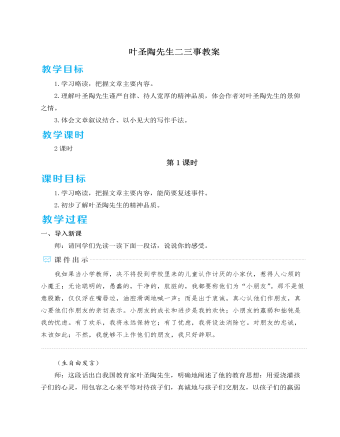
人教部编版七年级下册叶圣陶先生二三事教案
我认识圣陶先生是在成都,1941年春天的一个细雨蒙蒙的上午。那时候我在华西大学中国文化研究所工作,圣陶先生在四川省教育科学馆工作。教育科学馆计划出一套供中学语文教师用的参考书。其中有一本《精读指导举隅》和一本《略读指导举隅》,是由圣陶先生和朱佩弦先生合作编写的。计划里边还有一本讲文法的书,圣陶先生从顾颉刚先生那里知道我曾经在云南大学教过这门课,就来征求我的意见,能否答应写这样一本书。我第一次见到圣陶先生,跟我想象中的“文学家”的形象全不一样:一件旧棉袍,一把油纸雨伞,说话慢言细语,像一位老塾师。他说明来意之后,我答应试试看。又随便谈了几句关于语文教学的话,他就回去了。那时候圣陶先生从乐山搬来成都不久,住家和办公都在郊外。过了几天,他让人送来一套正中书局的国文课本,供我写书取用例句。
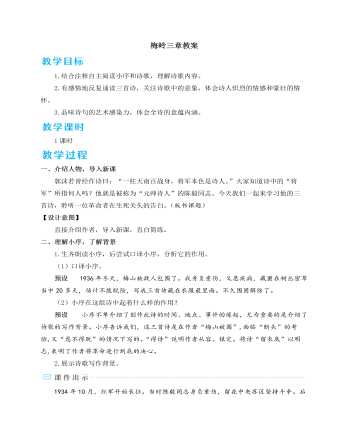
人教部编版语文九年级下册梅岭三章教案
(1)看题目。题目中蕴含着诸多信息,如时间、地点、人物、事件以及诗人的心情、诗歌的意境、诗歌的类型等。抓住这一切入点,有助于我们理解诗歌的思想感情。(2)看作者。作品是作者思想情感的具体化,所以,要准确理解诗词,把握作品的思想感情,就不能脱离作者孤立地臆断。作者的生平、写作风格、思想等等,无不影响着作者的情绪,所以,在鉴赏作品时,首先要了解作者的相关背景等。(3)看时代。把握时代风貌特征,把诗歌放在时代背景下评析,才能准确领悟其蕴含的思想感情。(4)看意象。诗歌的创作讲究含蓄、凝练。诗人的抒情往往不是情感的直接流露,而是注重弦外之音、言外之意。写景则借景抒情,咏物则托物言志。因此意象也就是作者的主观感情与客观物象的完美结合,是诗人情感显现的载体。把握诗中的意象,就能参悟意境,理解诗中蕴含的情感。
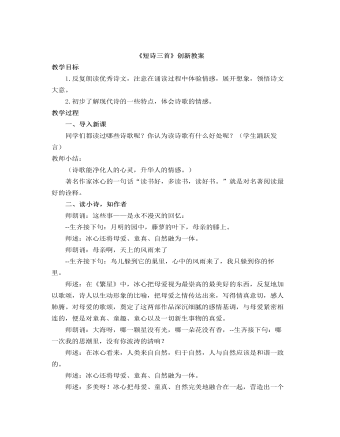
部编人教版四年级下册《 短诗三首》创新教案
教学目标1.反复朗读优秀诗文,注意在诵读过程中体验情感,展开想象,领悟诗文大意。2.初步了解现代诗的一些特点,体会诗歌的情感。教学过程一、导入新课同学们都读过哪些诗歌呢?你认为读诗歌有什么好处呢?(学生踊跃发言)教师小结:(诗歌能净化人的心灵,升华人的情感。)著名作家冰心的一句话“读书好,多读书,读好书。”就是对名著阅读最好的诠释。
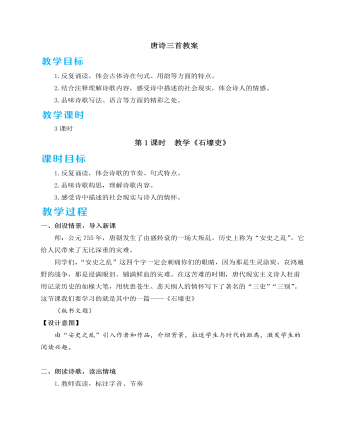
人教部编版语文八年级下册《唐诗三首》教案
(生练读课文)2.读出层次,概括内容师:请同学们自由朗读课文、借助课下注释,用自己的话把卖炭翁的故事讲给同桌听。故事示例:一个卖炭的老翁,一年到头都在终南山里砍柴、烧炭。他满脸灰尘,脸色完全是烟熏火燎的颜色;两鬓的头发已经斑白,十个指头却像炭一样黑。卖了炭得到一点钱,拿来做什么用呢?只不过是为了身上的衣裳和口中的饭食。可怜他身上的衣服破旧又单薄,但他却担心炭价太低,只盼望天气更加寒冷……(生自由朗读,根据课下注释理解内容,讲故事)师:请同学们用“人物+事件”的方式概述卖炭翁的遭遇。(生交流明确,师引导)预设 诗歌主要讲了一个卖炭翁辛苦烧的一车炭最终被宫使用半匹红纱一丈绫掠夺一空的故事。师:这首诗围绕着“炭”叙事,如果主体事件用“失炭”来概括的话,前面还记叙了哪些事?请同学们填空。

新人教版高中英语必修3Unit 1 Festivals and Celebrations教学设计一
本板块的活动主题是“谈论节日活动”(Talk about festival activities),主要是从贴近学生日常生活的角度来切入“节日”主题。学生会听到发生在三个国家不同节日场景下的简短对话,对话中的人们正在参与或将要亲历不同的庆祝活动。随着全球化的进程加速,国际交流日益频繁,无论是国人走出国门还是外国友人访问中国,都已成为司空见惯的事情。因此,该板块所选取的三个典型节日场景都是属于跨文化交际语境,不仅每组对话中的人物来自不同的文化背景,对话者的身份和关系也不尽相同。1. Master the new words related to holiday: the lantern, Carnival, costume, dress(sb)up, march, congratulation, congratulate, riddle, ceremony, samba, make - up, after all. 2. To understand the origin of major world festivals and the activities held to celebrate them and the significance of these activities;3. Improve listening comprehension and oral expression of the topic by listening and talking about traditional festivals around the world;4. Improve my understanding of the topic by watching pictures and videos about different traditional festivals around the world;5. Review the common assimilation phenomenon in English phonetics, can distinguish the assimilated phonemes in the natural language flow, and consciously use the assimilation skill in oral expression. Importance:1. Guide students to pay attention to the attitude of the speaker in the process of listening, and identify the relationship between the characters;2. Inspire students to use topic words to describe the festival activities based on their background knowledge. Difficulties:In the process of listening to the correct understanding of the speaker's attitude, accurately identify the relationship between the characters.

新人教版高中英语必修3Unit 2 Morals and virtues教学设计一
(2) students are divided into groups according to the requirements of activity 3. Each student shares a story of personal experience or hearing-witnessing kindness, and then selects the most touching story in the group and shares it with the whole class. Before the students share the story, the teacher can instruct them to use the words and sentence patterns in the box to express. For example, the words in the box can be classified:Time order: first of all, then, after that, later, finally logical relationship :so, however, although, butTeachers can also appropriately add some transitional language to enrich students' expression:Afterwards, afterwards, at last, in the end, eventuallySpatial order: next to, far from, on the left, in front ofOtherwise, nevertheless, as a result, therefore, furthermore, in addition, as well asSummary: in a word, in short, on the whole, to sum up, in briefStep 8 Homework1. Understand the definition of "moral dilemma" and establish a correct moral view;2. Accumulate vocabulary about attitudes and emotions in listening texts and use them to express your own views;3. Complete relevant exercises in the guide plan.1、通过本节内容学习,学生能否理解理解“道德困境”的定义;2、通过本节内容学习,学生能否通过说话人所表达的内容、说话的语气、语调等来判断其态度和情绪;3、通过本节内容学习,学生能否针对具体的道德困境发表自己的看法和见解,能否掌握听力理训练中的听力策略。

新人教版高中英语必修3Unit 3 Diverse Cultures教学设计四
该板块的活动主题是“介绍一个有显著文化特征的地方”( Describe a place with distinctive cultural identity)。该板块通过介绍中国城继续聚焦中国文化。本单元主题图呈现的是旧金山中国城的典型景象, Reading and Thinking部分也提到中国城,为该板块作铺垫。介绍中国城的目的主要是体现中国文化与美国多元文化的关系,它是美国多元文化的重要组成部分。中国城也是海外华人的精神家园和传播中国文化的重要窗口,外国人在中国城能近距离体验中国文化。1. Read the text to understand the cultural characteristics of Chinatown in San Francisco and the relationship between Chinese culture and American multiculturalism;2. Through reading, learn to comb the main information of the article, understand the author's writing purpose and writing characteristics;3. Learn to give a comprehensive, accurate, and organized description of the city or town you live in;Learn to revise and evaluate your writing.Importance:1. Guide the students to read the introduction of Chinatown in San Francisco and grasp its writing characteristics;2. Guide students to introduce their city or town in a comprehensive, accurate and organized way;3. Learn to comb the main information of the article, understand the author's writing purpose, and master the core vocabulary.

新人教版高中英语必修3Unit 3 Diverse Cultures教学设计一
Activity 81.Grasp the main idea of the listening.Listen to the tape and answer the following questions:Who are the two speakers in the listening? What is their relationship?What is the main idea of the first part of the listening? How about the second part?2.Complete the passage.Ask the students to quickly review the summaries of the two listening materials in activity 2. Then play the recording for the second time.Ask them to complete the passage and fill in the blanks.3.Play the recording again and ask the students to use the structure diagram to comb the information structure in the listening.(While listening, take notes. Capture key information quickly and accurately.)Step 8 Talking Activity 91.Focus on the listening text.Listen to the students and listen to the tape. Let them understand the attitudes of Wu Yue and Justin in the conversation.How does Wu Yue feel about Chinese minority cultures?What does Justin think of the Miao and Dong cultures?How do you know that?2.learn functional items that express concerns.Ask students to focus on the expressions listed in activity. 3.And try to analyze the meaning they convey, including praise (Super!).Agree (Exactly!)"(You're kidding.!)Tell me more about it. Tell me more about it.For example, "Yeah Sure." "Definitely!" "Certainly!" "No kidding!" "No wonder!" and so on.4.Ask the students to have conversations in small groups, acting as Jsim and his friends.Justin shares his travels in Guizhou with friends and his thoughts;Justin's friends should give appropriate feedback, express their interest in relevant information, and ask for information when necessary.In order to enrich the dialogue, teachers can expand and supplement the introduction of Miao, dong, Lusheng and Dong Dage.After the group practice, the teacher can choose several groups of students to show, and let the rest of the students listen carefully, after listening to the best performance of the group, and give at least two reasons.

新人教版高中英语选修2Unit 3 Learning about Language教学设计
1. We'll need ten months at least to have the restaurant decorated.2.Some traditional Chinese dishes from before the Ming Dynasty are still popular today.3.My grandpa's breakfast mainly includes whole grain biscuits and a glass of milk.4.People in this area would eat nearly a kilo of cheese per week.5. We enjoyed a special dinner in a fancy restaurant where the waiters all wore attractive suits.6. He prefers this brand of coffee which, as he said, has an unusually good flavor.Key:1. at a minimum 2. prior to3. consist of4. consume5. elegant6. exceptionalStep 5:Familiarize yourself with some food idioms by matching the meaning on the right with the colored words on the left.1.Public concern for the health of farm animals has mushroomed in the UK2.Anderson may be young but he's certainly rolling to doing dough!3.George is a popular lecturer. He often peppers his speech with jokes.4.As the person to bring home the bacon, he needs to find a stable job.5 He is often regarded as a ham actor for his over emphasized facial expressions. The media reported that these companies had treated pollution as a hot potato. 6.The media reported that these companies had treated pollution as a hot potato.7.Don't worry about the test tomorrow. It's going to be a piece of cake!8. It's best to fold the swimming ring when it is as flat as a pancake.A. completely flatB. something that is very easy to do C.an issue that is hard to deal withD.to include large numbers of somethingE.to earn on e's living to support a familyF. wealthyG.to rapidly increase in numberH. an actor who performs badly, especially by over emphasizing emotions

新人教版高中英语选修2Unit 5 Reading for writing教学设计
你校英语报计划出版一期急救常识专刊,现面向全校学生公开征集稿件,你有意参加。请你根据下面提示内容,用英语写一篇短文,介绍在车祸现场对伤者进行急救的方法和步骤。1.确保现场的安全;2.询问伤者,确保其呼吸正常;3.检查伤口,如流血则应采取止血措施;4.如需急救,确保其处于康复位置。注意:1.词数80左右;2.可以适当增加细节,以使行文连贯。参考词汇:康复位置 recovery positionAs we all know, having a knowledge of first aid can make a great difference in our daily life. If a traffic accident happens and someone is injured, the following steps can be used to treat the injured.In the first place, we should make sure that the accident scene is safe so that we won’t get hurt. We should ask the injured person if he is OK, and see if he is breathing. What’s more, we should check for cuts and wounds. If he is bleeding badly, it is vital that we should try to stop the bleeding by applying pressure to the injury. This is because if a person loses too much blood, he may die. If necessary, take the injured person to the hospital as soon as possible.Do remember: when giving first aid, please be sure to place the person in a recovery position.










